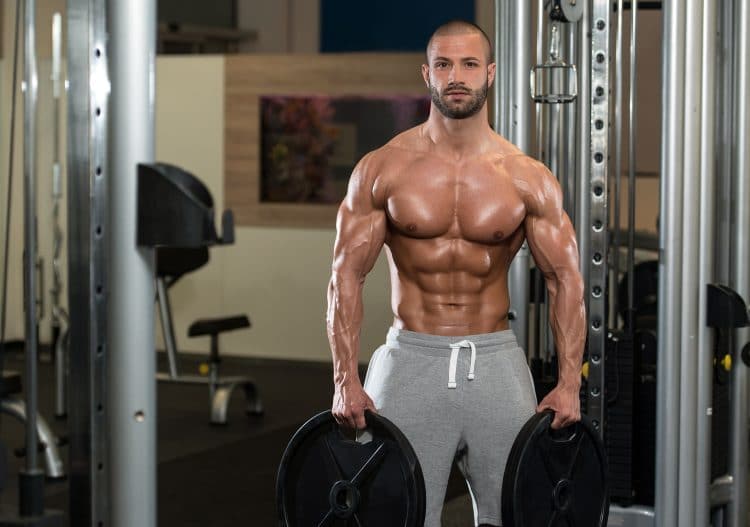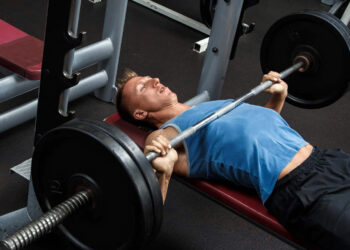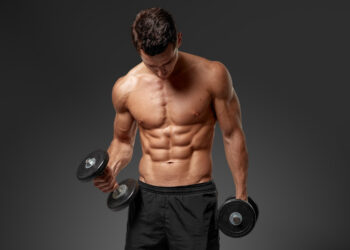Look at the average bodybuilding workout, and it’ll probably use the same set and rep scheme for all the exercises. More often than not, this will be something like three sets of ten, four sets of eight, or something similar.
Those same workouts also contain a lot of exercises per muscle group – typically 4-6.
While this training approach clearly works for some people, it may not be ideal for others. For example, natural lifters, older exercisers, and anyone blessed with average genetics may find it hard to build muscle using programs built around these training parameters.
There are a couple of reasons for this.
Using the same rep scheme means that muscles fatigue and fail within more-or-less the same timeframe during each and every set. The stimulatory effect of three sets of ten squats is much the same as three sets of ten leg presses. Only the exercise has changed.
Also, doing more than a few exercises per muscle group means you’re invariably repeating the same movement pattern over and over again. Your muscles can’t really differentiate between barbell bench presses, dumbbell bench presses, and Smith machine bench presses. The movements are so similar that their effects are all but identical.
Level Up Your Fitness: Join our 💪 strong community in Fitness Volt Newsletter. Get daily inspiration, expert-backed workouts, nutrition tips, the latest in strength sports, and the support you need to reach your goals. Subscribe for free!
The result is a lot of redundancy because you end up simply hitting the same muscle fibers with the same stimulus. This, for some lifters, is a waste of time and energy and does nothing other than delay recovery.
So, rather than trying to see how much exercise your body can tolerate, a better option would be to see how little you need to grow and get stronger.
While you could go as far as limiting yourself to one set of one exercise per body part, which is a system called high-intensity training, that’s probably not ideal either. HIT has as many drawbacks as advantages.
A better option is the 3-2-1 method which provides exercise variety while controlling training volume and using different rep ranges.
If you are stuck in a workout rut, shake things up and get back on track with the 3-3-1 method.
What Is The 3-2-1 Method?
The 3-2-1 method is as simple as it is effective. For each muscle group, choose three dissimilar exercises. Then do three heavy sets of the first exercise, two sets with a moderate weight of the second exercise, and one set with a light weight of the last exercise.
For example:
- Bench press – 3 sets of 6-8 reps
- Incline dumbbell press – 2 sets of 10-12 reps
- Cable crossovers – 1 set of 15-20 reps
This approach hits the target from three different angles, uses different rep ranges to stimulate different muscle fibers and motor units, and allows for accumulating fatigue. Also, limiting yourself to just three exercises forces you to choose the very best movements per body part.
Compared to a more usual bodybuilding approach, the 3-2-1 method means shorter workouts, fewer exercise redundancies, and faster recovery between workouts.
So, while there is nothing inherently wrong with the standard approach to bodybuilding, it may not work for everyone. If your current workout is not producing the results you want, why not try the 3-2-1 method. It could be just what you need to reignite your gains.
3-2-1 Workout
The 3-2-1 workout method is so simple that you should have no problem writing your own workouts. But, to save you the bother, we’ve created one for you.
This workout involves two upper body and two lower body workouts per week.
3-2-1 Workout Weekly Schedule
| Monday | Tuesday | Wednesday | Thursday | Friday | Saturday | Sunday |
| Legs & Core | Chest & Back | Rest | Legs & Calves | Rest | Shoulders & Arms | Rest |
Before you begin any of these workouts, make sure you spend some time warming up and preparing your muscles and joints for what you are about to do. Start with a few minutes of easy cardio followed by dynamic mobility and flexibility exercises for the muscles you’re about to work. Finish your warm-up with a couple of light sets of the first exercise in your workout.
3-2-1 Legs & Core Workout
| # | Exercise | Sets | Reps | Recovery |
| 1 | Front squat | 3 | 6-8 | 2 minutes |
| 2 | Leg press | 2 | 10-12 | 90 seconds |
| 3 | Sissy squat | 1 | 15-20 | 60 seconds |
| 4 | Rollout | 3 | 6-8 | 2 minutes |
| 5 | Cable woodchop | 2 | 10-12 | 90 seconds |
| 6 | Cable crunch | 1 | 15-20 | 60 seconds |
3-2-1 Chest & Back Workout
| # | Exercise | Sets | Reps | Recovery |
| 1 | Incline bench press | 3 | 6-8 | 2 minutes |
| 2 | Dips | 2 | 10-12 | 90 seconds |
| 3 | Cable crossover | 1 | 15-20 | 60 seconds |
| 4 | Pull-up | 3 | 6-8 | 2 minutes |
| 5 | Seated row | 2 | 10-12 | 90 seconds |
| 6 | Kroc row | 1 | 15-20 | 60 seconds |
Level Up Your Fitness: Join our 💪 strong community in Fitness Volt Newsletter. Get daily inspiration, expert-backed workouts, nutrition tips, the latest in strength sports, and the support you need to reach your goals. Subscribe for free!
3-2-1 Legs & Calves Workout
| # | Exercise | Sets | Reps | Recovery |
| 1 | Deadlift | 3 | 6-8 | 2 minutes |
| 2 | Romanian deadlift | 2 | 10-12 | 90 seconds |
| 3 | Leg curl | 1 | 15-20 | 60 seconds |
| 4 | Standing calf raise | 3 | 6-8 | 2 minutes |
| 5 | Seated calf raise | 2 | 10-12 | 90 seconds |
| 6 | Single-leg calf raise | 1 | 15-20 | 60 seconds |
3-2-1 Shoulders & Arms Workout
| # | Exercise | Sets | Reps | Recovery |
| 1 | Seated dumbbell press | 3 | 6-8 | 2 minutes |
| 2 | Cable lateral raise | 2 | 10-12 | 90 seconds |
| 3 | Upright row | 1 | 15-20 | 60 seconds |
| 4 | Barbell curl | 3 | 6-8 | 2 minutes |
| 5 | Preacher curl | 2 | 10-12 | 90 seconds |
| 6 | Concentration curl | 1 | 15-20 | 60 seconds |
| 7 | Close grip bench press | 3 | 6-8 | 2 minutes |
| 8 | Triceps pushdown | 2 | 10-12 | 90 seconds |
| 9 | Cable kickback | 1 | 15-20 | 60 seconds |
3-2-1 Workout FAQs
Got a question about the 3-2-1 method or the workouts? We’ve got the answers!
1. How much weight should I lift?
Unfortunately, we can’t tell you how much weight to lift because we don’t know how strong you are. Instead, you should choose a weight that takes you to failure within the prescribed rep range. So, if the program calls for 6-8 reps, if you can do more than eight, it’s too light, but if you can’t do six, it’s too heavy. Adjust your weights to keep you in the repetition “sweet spot.”
Also, do your best to add weight each week or do more reps. This will force your muscles to keep on adapting and growing.
2. Can I change the exercises?
By all means, change the exercises according to the equipment you have available. However, make sure you choose similar movements and do the most productive exercise first. For example, while Zercher squats are an acceptable alternative to front squats, leg extensions are not. Instead, try to stay true to the spirit of the program.
3. Is this a bulking or cutting program?
Your diet is what determines the effects of this program. If you eat less and create a calorie deficit, you’ll lose fat. However, if you eat more and create a calorie surplus, you’re more likely to bulk up. Adjust your diet to bulk or cut.
Read more about bulking vs. cutting in this guide.
4. What supplements should I use?
You don’t need to use any bodybuilding supplements if you don’t want to. In fact, you should be able to get most of the nutrients you need from a balanced diet. That said, there are some supplements that may enhance your progress.
Good choices include:
That’s not to say you need all or any of these supplements, but if you want to make better progress in less time, they could be helpful.
5. Why two leg workouts per week?
Your lower body makes up around 40 percent of your muscle mass. Still, many bodybuilders only dedicate 20-25% of their training week to developing them.
This could leave a lot of potential muscle growth untapped. Two leg workouts per week mean you can train your anterior and posterior leg muscles separately and build a better lower body.
Read more about this training philosophy here.
If you don’t have time for two leg workouts, consider doing this program instead:
| # | Exercise | Sets | Reps | Recovery |
| 1 | Front squat | 3 | 6-8 | 2 minutes |
| 2 | Lunges | 2 | 10-12 | 90 seconds |
| 3 | Leg extension | 1 | 15-20 | 60 seconds |
| 4 | Romanian deadlift | 3 | 6-8 | 2 minutes |
| 5 | Barbell hip thrust | 2 | 10-12 | 90 seconds |
| 6 | Leg curl | 1 | 15-20 | 60 seconds |
6. When should I do cardio?
With four workouts per week, there is plenty of time leftover for cardio. You can do it after your upper body workouts or on the designated rest days. However, it’s usually best to avoid doing cardio immediately after leg training.
Your muscles will probably be too tired for much running, cycling, rowing, etc. Alternatively, you can add a high-intensity finisher to your workouts instead of doing traditional cardio.
7. Is this workout suitable for beginners?
Because the volume is quite low, this is an ideal workout for beginners. It’s also suitable for intermediate lifters who find it hard to recover from more voluminous workouts, older exercisers, and anyone who prefers to spend less than an hour per workout. That said, more experienced exercisers can use it too, especially after a deload.
The 3-2-1 Method – Wrapping Up
Bodybuilding workouts are often long and complicated, but they don’t have to be. Unless you are very experienced, shorter and more straightforward workouts are often more effective.
The 3-2-1 method is very simple, saves time, and will help you to avoid overtraining and plateaus. Yet, despite its simplicity and brevity, this workout system is still very effective.
So, forget marathon workouts written for steroid-using full-time bodybuilders. Instead, use a training method designed for natural lifters with average genetics.











